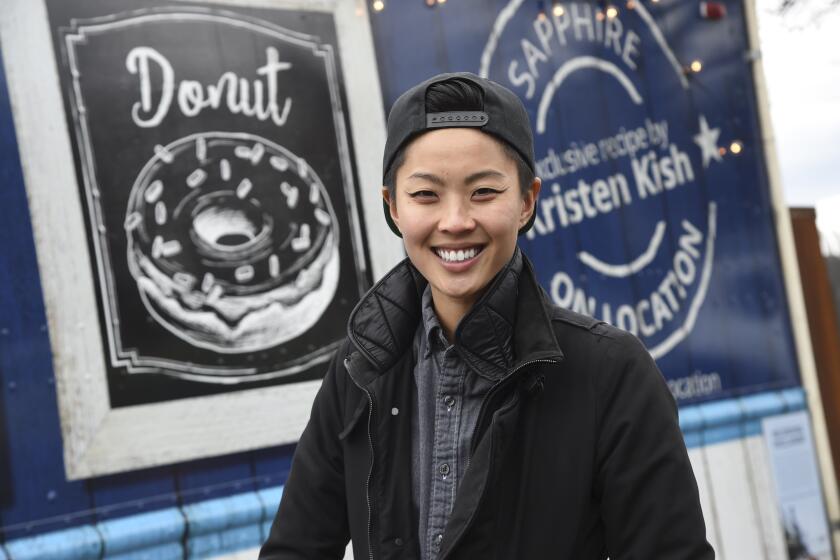Ruth Bader Ginsburg and Sandra Day O’Connor, the stage show, in ‘Sisters in Law’
- Share via
“We’re archetypes, the two of us, cliches. Smart brunette with glasses and all-American blonde,” Justice Ruth Bader Ginsburg tells Justice Sandra Day O’Connor in “Sisters in Law,” now in its West Coast premiere at the Wallis Annenberg Center for the Performing Arts in Beverly Hills.
Playwright Jonathan Shapiro, a former lawyer, based his script on Linda Hirshman’s dual biography of the first and second women to serve on the United States Supreme Court — watersheds so recent that both women are still with us. (O’Connor retired from the court in 2006, but Ginsburg remains famously active.) As Shapiro told an interviewer for Arizona Jewish Life, boiling history down into 90 lively stage minutes meant sacrificing some nuance, but he didn’t get too fanciful: “The arguments they have, the conflicts portrayed, it’s all true.”
Certainly O’Connor and Ginsburg, as played by the delightful Stephanie Faracy and Tovah Feldshuh, are very different people, not just in hair color but in background, philosophy, understanding of the function of the Supreme Court and feminist cred.
O’Connor, a moderate conservative, believes in incremental change; she may have broken through the glass ceiling, but she did so discreetly, not shattering it so much as carving an opening just her size.
Ginsburg, on the other hand, is a passionate feminist who’d love to smash that glass ceiling with a sledgehammer.
George Salazar (“Be More Chill”), Mj Rodriguez (“Pose”) and Amber Riley (“Glee”) bring a fresh take to the musical about a man-eating plant.
The play distills these differences (and some similarities) into a series of remarkably clear, expository conversations starting in 1993, when Ginsburg first moves into her Supreme Court office. O’Connor, who has been the only girl at the party for 12 years, stops by to offer a welcome and some decorating tips.
Ginsburg doesn’t want to talk mood lighting. She’d rather dive right into the upcoming labor law case Harris v. Forklift Systems Inc., which she sees as a rare opportunity to establish workplace protections for women. O’Connor argues that the court is supposed to apply laws, not write them. She also counsels Ginsburg against being pushy. “Or what, I’ll alienate the men?” Ginsburg snarls. “No, you’ll alienate me,” O’Connor says.
Shapiro’s engaging dialogue telescopes the justices’ personalities into punchy repartee, balanced so that neither decisively emerges victorious. Ginsburg’s attitude jibes better than O’Connor’s with ours now (she decided that time was up years before the rest of us), but she’s often dreary and self-righteous. O’Connor panders to the menfolk. There’s a scene in which she, during a golf game with her unseen husband, keeps simpering, “Nice putt, John!” But she’s also fun, a real cut-up, not above making jokes like, “Well, don’t make a federal case out of it!” while standing in the chambers of the Supreme Court.
It takes a while to notice that beyond their beautifully paced and illuminating banter, which sums up so many of the problems that still bedevil our society, nothing much happens in “Sisters in Law.” O’Connor and Ginsburg talk about cases in their respective offices. They talk in the robing room. They talk in Ginsburg’s hospital room in 1999, during her treatment for colon cancer, although this conversation actually turns out to be one of those hallucinations, attributable to heavy medication, to which biographical plays are oddly prone.
O’Connor retires and Ginsburg misses her; they meet again at an anniversary event and grieve together over not having made enough of a difference.
Fall theater season highlights for Los Angeles include a musical version of “Almost Famous,” Bill Irwin in “On Beckett,” a revival of August Wilson’s “Jitney” and a new stand-up show by comic Mike Birbiglia.
It’s during the hallucination that Ginsburg delivers the “smart brunette with glasses and all-American blonde” line, which seems out of keeping with the documentary-style realism that director Patricia McGregor has otherwise established. Yee Eun Nam’s projections, a trippy collage of black-and-white images, videos and headlines tracking the progress of time, along with the soundtrack of pop hits, conveys an expectation that what we’re watching is close to what happened.
The wonderful actresses (with help from costume designer Melissa Trn and hair and wig designer Judi Lewin) look and act uncannily like the justices they’re portraying. But the play as a whole doesn’t quite bring them to life; it oversimplifies them. At moments it reminded me of those feminist paper doll kits young girls are given: Smart Brunette With Glasses and the All-American Blonde on the Supreme Court.
Should we consider it condescending that the looks of pioneering women are still discussed in the same breath as their accomplishments, or should we take it as a compliment? Let’s face it, women just bring it — even while changing the world. When Ginsburg once was asked, “When will there be enough women on the Supreme Court?” she provocatively replied, “When there are nine.” That would be a triumph for humanity — and nearly enough looks for a wall calendar.
'Sisters in Law'
Where: Wallis Annenberg Center for the Performing Arts, Lovelace Studio Theater, 9390 N. Santa Monica Blvd., Beverly Hills
When: 8 p.m. Mondays-Fridays, 2:30 and 8 p.m. Saturdays, 2:30 and 7:30 p.m. Sundays, through Oct 13
Tickets: $60
Info: (310) 746-4000 or thewallis.org/sisters
Running time: 1 hour, 30 minutes (no intermission)
More to Read
The biggest entertainment stories
Get our big stories about Hollywood, film, television, music, arts, culture and more right in your inbox as soon as they publish.
You may occasionally receive promotional content from the Los Angeles Times.










